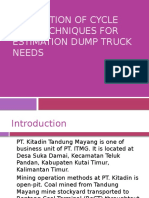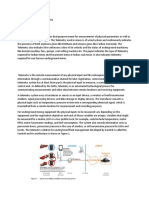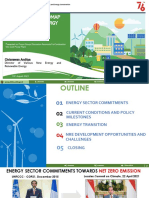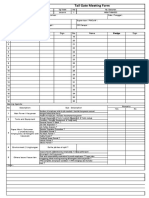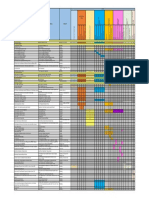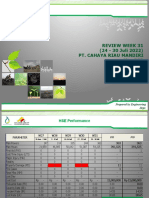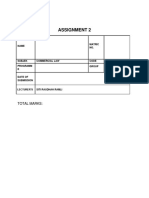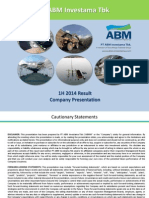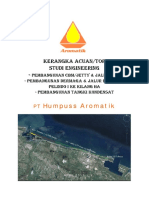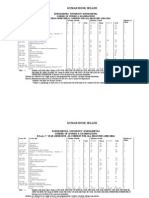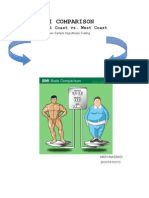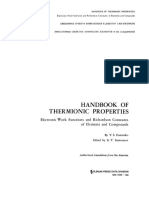Professional Documents
Culture Documents
Cost and Time Control of Construction Projects Due To Delays in Work Progress Based On POM-QM
Cost and Time Control of Construction Projects Due To Delays in Work Progress Based On POM-QM
Original Title
Copyright
Available Formats
Share this document
Did you find this document useful?
Is this content inappropriate?
Report this DocumentCopyright:
Available Formats
Cost and Time Control of Construction Projects Due To Delays in Work Progress Based On POM-QM
Cost and Time Control of Construction Projects Due To Delays in Work Progress Based On POM-QM
Copyright:
Available Formats
Volume 8, Issue 6, June 2023 International Journal of Innovative Science and Research Technology
ISSN No:-2456-2165
Cost and Time Control of Construction Projects
due to Delays in Work Progress based on POM-QM
Robby Juni Fair, MawardiAmin
Civil Engineering Department Mercu Buana University Jakarta, Indonesia
Abstract:- Proper and planned construction Aspena Apartments; Odds or Time Probability.
management in managing time and costs which is a
benchmark in the success of a project. A construction I. INTRODUCTION
project, in its implementation, often finds a condition
where optimization must be carried out precisely and A construction project, in its implementation, often
quickly in meeting the time demands of a contract which finds a condition where optimization must be carried out
reflects the wishes of an owner as a provider of funds. precisely and quickly in meeting the time demands of a
Therefore, it is necessary to use the Time and Cost contract which reflects the wishes of an owner as a provider
Prediction Application for Construction Projects to be of funds. This is certainly done effectively (doing the right
able to estimate the time and costs required so that the things) and efficiently (doing the right things) by not
project can be completed on time. One method that can forgetting the quality and use of work costs. Even though an
be used is the POM-QM Based Linear Programming activity has been planned as well as possible, it still contains
method. This research is focused on knowing: uncertainty that later it will go completely according to plan.
1
Optimization of project completion costs; Risk is always present in construction projects and often
2
Optimization of project completion time; 3Opportunity causes schedule delays or cost increases (Wang & Chou,
or probability of project completion time. The data used 2003).
is from the Aspena Residence-Tangerang Apartment
Project, in terms of architectural work from the 5th Such as the research that is being examined on the
floor to the 11th floor. The results of this study are: Aspena Residence Apartment Project in Tangerang, where
1
Optimization of the acceleration time in completing this the actual progress is 72.137% of the progress planned of
project is 56 weeks (normal time 99 weeks); 2Crashing 81.309%, resulting in a minus deviation or delay in project
costs (acceleration optimization costs) obtained progress of -9.172%.
amounting to IDR 1,624,910,000; 3Opportunities or time
Therefore, a project control planning method is
probabilities with a value of Z = 3.063 and a probability
needed, one of the methods that can be used is the POM-
of 99.8%. From this research, the researcher hopes that
QM Software.The POM-QM program is a computer
this research can be useful for related parties as
program that is used to solve quantitative management
material for consideration in planning and evaluating
problems in production and operations. Ease of operation
project completion time, as well as for other new
makes POM-QM for Windows V.5.2 an alternative
projects.
application to help decision making.
Keywords:- Cost and Time Optimization; POM-QM;
Table 1: Project Problem Identification
No Problem Identification Causes of Problems
1 Reducing the construction of the number of floors of Customer/Tenant targets not achieved
apartments from 12 floors to 11 floors;
2 Delays in work progress that experience Deviations; - Unstable work productivity; lack of control over
9.172% labor resources and material use
This research aims to: II. METHODOLOGY
To determine the optimization of the time and cost of
project completion. Based on the background, the formulation of the
To determine the number of work items that can be problem and the objectives to be achieved, this research is of
processed time/crashing activities in the network, to the nature of Statistical Analysis where to answer the
reduce time on the critical path. formulation of the problem a concept or theory is used so
To determine the opportunity or probability of project that a hypothesis is formulated how to analyze Cost and
completion time. Time Optimization due to delays in work on the Aspena
Residence Apartment Project-Tangerang. This type of
research is quantitative research, namely research that
emphasizes numerical data (numbers) processed by
statistical methods (Azwar, 2007: 5).
IJISRT23JUN997 www.ijisrt.com 1291
Volume 8, Issue 6, June 2023 International Journal of Innovative Science and Research Technology
ISSN No:-2456-2165
Fig. 1: Research Model
In this study, the object studied was architectural Information:
work (5th floor to 11th floor). Primary data collection is Z = Probability (chance)
carried out by collecting project data such as the Cost T(d) = Deadline
Budget Plan (RAB), S Curve, Work Unit Prices, which have TE = Expected Completion Time
been planned, reports on the physical progress of project S = Standard Deviation Total Variance
work. And there are 32 work items made in the form of
symbols from each work item. After the value of z is obtained, the probability number
can be searched using the Appendix table of the
The data input and output methods were made using Cumulative Normal Distribution (Z). The probability
the POM-QM Software for Windows V.5.2. Where the results obtained indicate the probability that the project
POM-QM project management analysis uses the PERT will be completed within the planned timeframe.
(Program Evaluation and Review Technique) method.
PERT is a project scheduling method that is engineered to
deal with high uncertainty in the duration of project
activities by taking an approach that assumes that the
duration of activities is influenced by many factors so that a
range is applied using three estimates. The three estimates
are the pessimistic time (tp), the most likely or most likely
estimate time (tm), and the optimistic time (to) .
To determine the probability/probability, this study
uses the PERT probability theory,which explains:
Distribution curve and variablesThe three estimates
are the pessimistic time ( b ), the most likely or
most likely forecast time (m), and the optimistic
time ( a ) .
Standard deviation and variance
Completion schedule targets
T(d)-TE
Z=
S
IJISRT23JUN997 www.ijisrt.com 1292
Volume 8, Issue 6, June 2023 International Journal of Innovative Science and Research Technology
ISSN No:-2456-2165
Table 2: Symbol of Project Activity (Floor 5 to Floor 11)
No Work Activity Symbol
1 Wall Waterproffing Coating A1
2 Waterproffing Membrane A2
3 Wall Ceramics B1
4 Gypsum ceiling C1
5 GRC (Glass Reinforced Concrete) Board C2
6 GRC WR (Water resistance) Board C3
7 Shadow Lines C4
8 ACP (Alumunium Composite Panel) D1
9 Ceramic Floor 60x60 cm in Units E1
10 Ceramic Floor 30x30 cm in Balcony & Toilet E2
11 Ceramic Lobby Elevator E3
12 Balcony Ceramic Plint & Panel Room F1
13 Ceramic plinth HT (Homogenus tile) 10/60 cm F2
14 Ceramic Plint HT 10/30 cm (balcony unit) F3
15 Wooden Door (Unit) P1 G1
16 PB1 Iron Door G2
17 Fire Door PB2A G3
18 Door R Panel PB3 G4
19 GR1 ventilation (emergency stairway & trash room) G5
20 PS1 Shafts G6
21 PS2 Shafts G7
22 Aluminum P3 door (balcony) G8
23 P2 UPVC door (toilet) G9
24 Studio Unit Aluminum Window G10
25 Aluminum Window 1,800x1,150 cm 1 BR (unit) G11
26 Aluminum Window 1,200x1,150 cm 1 BR (unit) G12
27 J4 Window Aluminum Grill Jalus 800x1,150 cm In Corridor G13
28 J5 Aluminum windows uk 2,400x1,150 cm in Unit 1 BR G14
29 Interior Wall Paint H1
30 Facade Paint H2
31 Exterior Paint H3
32 Ceiling Paint H4
III. OPERATIONAL STEPS USING QM FOR WINDOWS (POM-QM)
Open the program then click Module
IJISRT23JUN997 www.ijisrt.com 1293
Volume 8, Issue 6, June 2023 International Journal of Innovative Science and Research Technology
ISSN No:-2456-2165
Select Project Management (PERT/CPM)
Click Files
Click New and move the cursor to the crashing menu.
Click Crashing and click Ok. Input data on the number of activities
IJISRT23JUN997 www.ijisrt.com 1294
Volume 8, Issue 6, June 2023 International Journal of Innovative Science and Research Technology
ISSN No:-2456-2165
Start working with input in the column activity, normal time, crash time, normal cost, crash cost and predecessors.
After inputting data, click the solve menu at the top left of the application window.
On the solution menu, select Chart, so you get an example of a chart diagram.
IJISRT23JUN997 www.ijisrt.com 1295
Volume 8, Issue 6, June 2023 International Journal of Innovative Science and Research Technology
ISSN No:-2456-2165
Calculating crashing selected crashing sub menu (For crashing and three-time estimate can be done by clicking on the menu
crashing and three-time estimate)
IV. RESULTS AND DISCUSSION Budget plan of project implementation
(Architect Work from 5th floor to 11th floor).
This chapter will also describe in detail the The latest condition of the progress report for
optimization of project time and costs using the crashing September 2021, is to find out how much the
method. Data analysis was carried out by inputting data project is experiencing delays in progress.
directly into the Microsoft Excel program, which includes Weekly report : the last 4 months (from
three stages, namely: September to December 2021) to find out the
number of workers in each item of architectural
A. Develop a project schedule and cost plan (baseline) . work that will be optimized.
The work standard that will be set is based on
the SNI (Indonesian National Standard) Worker
Unit Analysis.
IJISRT23JUN997 www.ijisrt.com 1296
Volume 8, Issue 6, June 2023 International Journal of Innovative Science and Research Technology
ISSN No:-2456-2165
Table 3: Initial Conditions; Actual Progress Project
Normal Deadline
Actual Remaining
No Work Activity Symbol Time Time
Progres Progress
Weeks Weeks
1 Wall Waterproffing Coating A1 30% 70% 12 6
2 Waterproffing Membrane A2 30% 70% 7 4
3 Wall Ceramics B1 20% 80% 25 16
4 Gypsum ceiling C1 30% 70% 18 8
5 GRC(Glass Reinforced Concrete) Board C2 40% 60% 2 1
6 GRC Board WR (Water Resistant) C3 40% 60% 3 1
7 Shadow Line (List Ceiling) C4 0% 100% 5 4
8 ACP (Aluminum Composite Panel) D1 30% 70% 46 25
9 Ceramic Floor 60x60 cm in Units E1 30% 70% 28 15
Ceramic Floor 30x30 cm in Balcony &
10 E2 30% 70% 3 2
Toilet
11 Ceramic Lobby Elevator E3 30% 70% 3 2
12 Balcony Ceramic Plint & R. Panel F1 0% 100% 4 3
Ceramic plinth HT (Homogenus Tile)
13 F2 0% 100% 13 10
10/60 cm
Ceramic Plint HT (Homogenus Tile) 10/30
14 F3 0% 100% 4 3
cm (balcony unit)
15 Wooden Door (Unit) P1 G1 20% 80% 40 25
16 PB1 Iron Door G2 30% 70% 1 1
17 Iron Door Fire Door PB2A G3 30% 70% 1 1
18 Door R Panel PB3 G4 30% 70% 1 1
GR1 Iron Grill Ventilation (emergency
19 G5 30% 70% 3 2
stairs & trash room)
20 Iron Door PS1 Shaft G6 30% 70% 12 7
21 PS2 Shaft Iron Door G7 30% 70% 2 1
22 Aluminum P3 door (balcony) G8 30% 70% 6 3
23 P2 UPVC door (toilet) G9 30% 70% 6 3
24 Studio Unit Aluminum Window G10 30% 70% 4 2
Aluminum Window 1800x1150 1 BR
25 G11 30% 70% 3 2
(unit)
Aluminum Window 1,200x1,150 cm 1 BR
26 G12 30% 70% 1 1
(unit)
J4 Window Aluminum Grill Jalus
27 G13 30% 70% 1 1
800x1150 cm In Corridor
J5 Aluminum windows 2,400x1,150 cm in
28 G14 30% 70% 1 1
Unit 1 BR
29 Interior Wall Paint H1 0% 100% 78 14
30 Facade Paint H2 0% 100% 15 12
31 Exterior Paint H3 0% 100% 12 9
32 Ceiling Paint H4 0% 100% 20 16
Table 3 describes the weight of work and the remaining time for each job and explains the symbols for the type of work to
be used for input in the POM-QM software.
IJISRT23JUN997 www.ijisrt.com 1297
Volume 8, Issue 6, June 2023 International Journal of Innovative Science and Research Technology
ISSN No:-2456-2165
Table 4: Activity Normal Costs
Normal Costs
No Work Activity S ymbol
(IDR)
1 Wall Waterp roffing Coating A1 190.220.000
2 Waterp roffing M embrane A2 340.570.000
3 Wall Ceramics B1 999.540.000
4 Gy p sum ceiling C1 641.030.000
5 GRC (Glass Reinforced Concrete) Board C2 69.350.000
6 GRC Board WR (Water Resistant) C3 82.790.000
7 Shadow Line (List Ceiling) C4 118.880.000
8 ACP (Aluminum Comp osite Panel) D1 1.634.920.000
9 Ceramic Floor 60x60 cm in Units E1 304.960.000
10 Ceramic Floor 30x30 cm in Balcony & Toilet E2 265.770.000
11 Ceramic Lobby Elevator E3 52.200.000
12 Balcony Ceramic Plint & R. Panel F1 32.230.000
13 Ceramic p linth HT (Homogenus Tile) 10/60 cm F2 3.760.000
14 Ceramic Plint HT (Homogenus Tile) 10/30 cm (balcony unit) F3 1.920.180.000
15 Wooden Door (Unit) P1 G1 214.660.000
16 PB1 Iron Door G2 318.900.000
17 Iron Door Fire Door PB2A G3 39.160.000
18 Door R Panel PB3 G4 23.300.000
19 GR1 Iron Grill Ventilation (emergency stairs & trash room) G5 651.940.000
20 Iron Door PS1 Shaft G6 175.970.000
21 PS2 Shaft Iron Door G7 1.374.680.000
22 Aluminum P3 door (balcony ) G8 898.470.000
23 P2 UPVC door (toilet) G9 232.470.000
24 Studio Unit Aluminum Window G10 338.720.000
25 Aluminum Window 1800x1150 1 BR (unit) G11 48.520.000
26 Aluminum Window 1,200x1,150 cm 1 BR (unit) G12 33.690.000
27 J4 Window Aluminum Grill Jalus 800x1150 cm In Corridor G13 31.000.000
28 J5 Aluminum windows 2,400x1,150 cm in Unit 1 BR G14 2.725.770.000
29 Interior Wall Paint H1 523.250.000
30 Facade Paint H2 162.020.000
31 Exterior Paint H3 125.730.000
32 Ceiling Paint H4 196.920.000
Totals: 14.771.570.000
Table 4. Describes the normal cost of activities. The B. Develop a Crashing plan to get optimization.
financing for this project is also divided into two divisions, Optimization is done by filling in data that will be
namely material costs, and wages. In this study, for material optimized to be compared with the plan (baseline).
and wage costs, the author takes the basic unit price that Calculating work time optimization, with the addition of
already exists in the budget plan of the project being studied a target volume of work to be completed in 1 day.
(Source: Taspen Project) Calculating the number of workers required for the
optimized work item.
Calculating the additional costs incurred due to
optimization.
Table 5: Activity Time Project
NORMAL TIME Crashing TIME
NO SYMBOL JOB DESCRIPTION
(Weeks) (Weeks)
1 A1 Wall Waterproffing Coating 12 6
2 A2 Waterproffing Membrane 7 4
3 B1 Wall Ceramics 25 16
4 C1 Gypsum ceiling 18 8
5 C2 GRC (Glass Reinforced Concrete) Board 2 1
6 C3 GRC WR (Water Resistant) 3 1
7 C4 Shadow Line (List Ceiling) 5 4
8 D1 ACP (Aluminum Composite Panel) 46 25
9 E1 Ceramic Floor 60x60 cm in Units 28 15
IJISRT23JUN997 www.ijisrt.com 1298
Volume 8, Issue 6, June 2023 International Journal of Innovative Science and Research Technology
ISSN No:-2456-2165
10 E2 Ceramic Floor 30x30 cm in Balcony & Toilet 3 2
11 E3 Ceramic Lobby Elevator 3 2
12 F1 Balcony Ceramic Plint & R. Panel 4 3
13 F2 Ceramic plinth HT 10/60 cm 13 10
14 F3 Ceramic Plint HT 10/30 cm (balcony unit) 4 3
15 G1 Wooden Door (Unit) P1 40 25
16 G2 PB1 Iron Door 1 1
17 G3 Iron Door Fire Door PB2A 1 1
18 G4 Door R Panel PB3 1 1
GR1 Iron Grill Ventilation (emergency stairs & trash
19 G5 3 2
room)
20 G6 Iron Door PS1 Shaft 12 7
21 G7 PS2 Shaft Iron Door 2 1
22 G8 Aluminum P3 door (balcony) 6 3
23 G9 P2 UPVC door (toilet) 6 3
24 G10 Studio Unit Aluminum Window 4 2
25 G11 Aluminum Window 1,800x1,150 cm 1 BR (unit) 3 2
26 G12 Aluminum Window 1,200x1,150 cm 1 BR (unit) 1 1
J4 Window Aluminum Grill Jalus 800x1,150 cm In
27 G13 1 1
Corridor
28 G14 J5 Aluminum windows 2,400x1,150 cm in Unit 1 BR 1 1
29 H1 Interior Wall Paint 78 14
30 H2 Facade Paint 15 12
31 H3 Exterior Paint 12 9
32 H4 Ceiling Paint 20 16
Table 5. describes the project acceleration time which Normal Productivity:
is carried out by performing calculations based on the basic
calculation of work volume from SNI (Indonesian National Remaining volume 5,222.25
=
Standart). Normal duration 25
Calculation example 1 (Wall Ceramic – B1): = 208.89 m2 /weeks
Actual progress = 20%
Remaining progress = 80% Crashing Productivity:
Initial volume = 6527.81 m2
Productivity normal 208.89
Residual volume = 5,222.25 m2 =
Vol SNI = 14.286 m2/day (1 worker/day) Koef. Crashing 1.6
= 14.286 x 7 days
= 100.002 m2/day = 334.224 𝑚2 /weeks
Workers = 3 people Crash duration:
Normal time = 25 weeks
Deadline time = 16 weeks Remaining volume 5,222.25
=
Crashing productivity 334.224
= 15.27 weeks = 16 weeks
Table 6: Activity Predecessor
Activity time Predecessor Predecessor Predecessor
Activity
(weeks) 1 2 3
A1 12
A2 7 a1
B1 25 a1
C1 18 b1 a1
C2 2 b1 c1
C3 3 b1
C4 5 a1 c3
D1 46 a1
E1 28 d1
E2 3 b1
E3 3 e2 c2
IJISRT23JUN997 www.ijisrt.com 1299
Volume 8, Issue 6, June 2023 International Journal of Innovative Science and Research Technology
ISSN No:-2456-2165
F1 4 e2
F2 13 e1 c4
F3 4 e2
G1 40 f3 f1
G2 1 e2
G3 1 g2 g1
G4 1 g3 e3
G5 3 g4
G6 12 g5
G7 2 g6
G8 6 e2 g7
G9 6 b1
G10 4 g9
G11 3 g10
G12 1 g11
G13 1 g12
G14 1 g13 g12
H1 78 a1 a2
H2 15 a1 g13 g7
H3 12 c4
H4 20 c1
Fig. 2: Network Diagrams
Table 7: Forward and backward calculations and total float
Activity time Early Early Late Late
Activity slack
(weeks) Start Finish Start Finish
Project 99
A1 12 0 12 0 12 0
A2 7 12 19 14 21 2
B1 25 12 37 18 43 6
C1 18 37 55 43 61 6
C2 2 55 57 61 63 6
C3 3 37 40 78 81 41
C4 5 40 45 81 86 41
D1 46 12 58 12 58 0
E1 28 58 86 58 86 0
E2 3 37 40 52 55 15
E3 3 57 60 63 66 6
F1 4 40 44 55 59 15
F2 13 86 99 86 99 0
F3 4 40 44 55 59 15
G1 40 44 84 59 99 15
IJISRT23JUN997 www.ijisrt.com 1300
Volume 8, Issue 6, June 2023 International Journal of Innovative Science and Research Technology
ISSN No:-2456-2165
G2 1 40 41 64 65 24
G3 1 41 42 65 66 24
G4 1 60 61 66 67 6
G5 3 61 64 67 70 6
G6 12 64 76 70 82 6
G7 2 76 78 82 84 6
G8 6 78 84 93 99 15
G9 6 37 43 69 75 32
G10 4 43 47 75 79 32
G11 3 47 50 79 82 32
G12 1 50 51 82 83 32
G13 1 51 52 83 84 32
G14 1 52 53 98 99 46
H1 78 19 97 21 99 2
H2 15 78 93 84 99 6
H3 12 45 57 87 99 42
H4 20 55 75 79 99 24
Under accelerated conditions, it can be seen in Table 7, that activities that are on a critical path with a slack value of zero
(0) are activities:
A1 = Waterproof Coating
D1 = ACP (alumunium composite panel)
E1 = Ceramic Floor 60x60 cm Units
F2 = Ceramic Plint HT 10/60 cm
The required acceleration time is 99 weeks.
In the next condition relaxation is carried out, this changes the working time. There are 32 activities that can be accelerated
as attached in Table 8 below:
Table 8: Calculation of forward and backward and total float (after relaxation)
Activity time Early Early Late Late
Activity slack
weeks Start Finish Start Finish
Project 93,83
A1 11.33 0.00 11.33 0.00 11.33 0.00
A2 6,67 11.33 18.00 72,33 79.00 61.00
B1 24.00 11.33 35,33 24,67 48,67 13,33
C1 16,67 35,33 52.00 57.50 74,17 22,17
C2 2.00 35,33 37,33 80.00 82.00 44,67
C3 2.83 35,33 38,17 91.00 93,83 55,67
C4 5.00 11.33 16,33 88,83 93,83 77.50
D1 43,33 11.33 54,67 11.33 54,67 0.00
E1 26,33 54,67 81.00 54,67 81.00 0.00
E2 3.00 35,33 38,33 48,67 51,67 13,33
E3 3.00 38,33 41.33 90.83 93,83 52.50
F1 4.00 38,33 42,33 89,83 93,83 51.50
F2 12.83 81.00 93,83 81.00 93,83 0.00
F3 4.00 38,33 42,33 51,67 55,67 13,33
G1 38,17 42,33 80.50 55,67 93,83 13,33
G2 1.17 38,33 39.50 73,83 75.00 35.50
G3 1.17 39.50 40,67 75.00 76,17 35.50
G4 1.17 40,67 41.83 76,17 77,33 35.50
G5 3.00 41.83 44,83 77,33 80.33 35.50
G6 11.50 44,83 56,33 80.33 91.83 35.50
G7 2.00 56,33 58,33 91.83 93,83 35.50
G8 5,67 38,33 44.00 88,17 93,83 49,83
G9 5,67 35,33 41.00 77,83 83.50 42.50
G10 3.83 41.00 44,83 83.50 87.33 42.50
G11 3.00 44,83 47,83 87.33 90.33 42.50
G12 1.17 47,83 49.00 90.33 91.50 42.50
IJISRT23JUN997 www.ijisrt.com 1301
Volume 8, Issue 6, June 2023 International Journal of Innovative Science and Research Technology
ISSN No:-2456-2165
G13 1.17 49.00 50,17 91.50 92.67 42.50
G14 1.17 50,17 51,33 92.67 93,83 42.50
H1 68,67 11.33 80.00 25,17 93,83 13.83
H2 14.83 18.00 32,83 79.00 93,83 61.00
H3 11.83 37,33 49,17 82.00 93,83 44,67
H4 19.67 52.00 71,67 74,17 93,83 22,17
In table 8, the amount of time needed is 93.83 weeks.
Fig. 3: Network Diagrams
C. Perform optimization analysis.
Table 9: Crashing schedule Critical Path Method
Activity Normal time Crash time Normal Cost Crash Cost Δ ΔCost ΔCost /
(Nt) weeks (Ct) weeks (IDR) (Nc) (IDR) (Cc) Weeks (IDR) Δ Weeks (IDR)
Project 93,83 56.00
A1 11.33 6.00 190,220,000 211,140,000 5,33 20,920,000 3,486,700
A2 6,67 4.00 340,570,000 378,040,000 2.67 37,470,000 12,490,000
B1 24.00 16.00 999,540,000 1,109,490,000 8.00 109,950,000 12,216,700
C1 16,67 8.00 641,030,000 711,540,000 8.67 70,510,000 7,051,000
C2 2.00 1.00 69,350,000 76,980,000 1.00 7,630,000 7,630,000
C3 2.83 1.00 82,790,000 91,900,000 1.83 9,110,000 4,555,000
C4 5.00 4.00 118,880,000 131,960,000 1.00 13,080,000 13,080,000
D1 43,33 25.00 1,634,920,000 1,814,760,000 18.33 179,840,000 8,563,800
E1 26,33 15.00 304,960,000 338,510,000 11.33 33,550,000 2,580,800
E2 3.00 2.00 265,770,000 295,010,000 1.00 29,240,000 29,240,000
E3 3.00 2.00 52,200,000 57,940,000 1.00 5,740,000 5,740,000
F1 4.00 3.00 32,230,000 35,770,000 1.00 3,540,000 3,540,000
F2 12.83 10.00 3,760,000 4,170,000 2.83 410,000 136,700
F3 4.00 3.00 1,920,180,000 2,131,400,000 1.00 211,220,000 211,220,000
G1 38,17 25.00 214,660,000 238,270,000 13,17 23,610,000 1,574,000
G2 1.00 1.00 318,900,000 353,980,000 - 35,080,000 -
G3 1.00 1.00 39,160,000 43,460,000 - 4,300,000 -
G4 1.00 1.00 23,300,000 25,860,000 - 2,560,000 -
G5 3.00 2.00 651,940,000 723,660,000 1.00 71,720,000 71,720,000
G6 11.50 7.00 175,970,000 195,330,000 4.50 19,360,000 3,872,000
G7 2.00 1.00 1,374,680,000 1,525,900,000 1.00 151,220,000 151,220,000
G8 5,67 3.00 898,470,000 997,310,000 2.67 98,840,000 32,946,700
G9 5,67 3.00 232,470,000 258,050,000 2.67 25,580,000 8,526,700
G10 3.83 2.00 338,720,000 375,980,000 1.83 37,260,000 18,630,000
G11 3.00 2.00 48,520,000 53,860,000 1.00 5,340,000 5,340,000
G12 1.00 1.00 33,690,000 37,400,000 - 3,710,000 -
G13 1.00 1.00 31,000,000 34,410,000 - 3,410,000 -
G14 1.00 1.00 2,725,770,000 3,025,610,000 - 299,840,000 -
H1 68,67 14.00 523,250,000 580,800,000 54,67 57,550,000 899,200
H2 14.83 12.00 162,020,000 179,840,000 2.83 17,820,000 5,940,000
H3 11.83 9.00 125,730,000 139,570,000 2.83 13,840,000 4,613,300
H4 19.67 16.00 196,920,000 218,580,000 3.67 21,660,000 5,415,000
Totals 14,771,570,000 1,624,910,000
IJISRT23JUN997 www.ijisrt.com 1302
Volume 8, Issue 6, June 2023 International Journal of Innovative Science and Research Technology
ISSN No:-2456-2165
Table 10: List of Activities, optimistic time, most likely time, pessimistic time, standard deviation, and variance
Activity Activity Early Early Late Late slack Standard Variances
time Start Finish Start Finish Deviations
Project 93,83 5,33 28,36
A1 11.33 - 11.33 - 11.33 - 1.33 1.78
A2 6,67 11.33 18.00 18.50 25,17 7,17 0.67 0.44
B1 24.00 11.33 35,33 15,67 39,67 4,33 2.00 4.00
C1 16,67 35,33 52.00 39,67 56,33 4,33 2.00 4.00
C2 2.00 52.00 54.00 56,33 58,33 4,33 0.33 0.11
C3 2.83 35,33 38,17 73,17 76.00 37,83 0.50 0.25
C4 5.00 38,17 43,17 76.00 81.00 37,83 0.33 0.11
D1 43,33 11.33 54,67 11.33 54,67 - 4,33 18.78
E1 26,33 54,67 81.00 54,67 81.00 - 2.67 7,11
E2 3.00 35,33 38,33 48,67 51,67 13,33 0.33 0.11
E3 3.00 54.00 57.00 58,33 61,33 4,33 0.33 0.11
F1 4.00 38,33 42,33 51,67 55,67 13,33 0.33 0.11
F2 12.83 81.00 93,83 81.00 93,83 - 0.83 0.69
F3 4.00 38,33 42,33 51,67 55,67 13,33 0.33 0.11
G1 38,17 42,33 80.50 55,67 93,83 13,33 3,17 10.03
G2 1.17 38,33 39.50 59.00 60,17 20,67 0.17 0.03
G3 1.17 39.50 40,67 60,17 61,33 20,67 0.17 0.03
G4 1.17 57.00 58,17 61,33 62.50 4,33 0.17 0.03
G5 3.00 58,17 61,17 62.50 65.50 4,33 0.33 0.11
G6 11.50 61,17 72,67 65.50 77.00 4,33 1.17 1.36
G7 2.00 72,67 74,67 77.00 79.00 4,33 0.33 0.11
G8 5,67 74,67 80.33 88,17 93,83 13.50 0.67 0.44
G9 5,67 35,33 41.00 64,17 69,83 28,83 0.67 0.44
G10 3.83 41.00 44,83 69,83 73,67 28,83 0.50 0.25
G11 3.00 44,83 47,83 73,67 76,67 28,83 0.33 0.11
G12 1.17 47,83 49.00 76,67 77,83 28,83 0.17 0.03
G13 1.17 49.00 50,17 77,83 79.00 28,83 0.17 0.03
G14 1.17 50,17 51,33 92.67 93,83 42.50 0.17 0.03
H1 68,67 18.00 86,67 25,17 93,83 7,17 12.00 144.00
H2 14.83 74,67 89.50 79.00 93,83 4,33 0.83 0.69
H3 11.83 43,17 55.00 82.00 93,83 38,83 0.83 0.69
H4 19.67 52.00 71,67 74,17 93,83 22,17 1.00 1.00
IJISRT23JUN997 www.ijisrt.com 1303
Volume 8, Issue 6, June 2023 International Journal of Innovative Science and Research Technology
ISSN No:-2456-2165
Fig. 4: Gantt Chart Early times
The activity in Figure 4, which is located on the red line, is the critical path. So, by using PERT it can be determined the
sequence of work and the attachment relationship between work activities that cannot be separated. This attachment can be seen if
certain work has not been done, then the next work cannot be done.
Table 11: Activity Time Computations
Optimistic time Most likely time Pessimistic time Activity time Standard Deviations Variances
A1 6.00 12.00 14.00 11.33 1.33 1.78
A2 4.00 7.00 8.00 6,67 0.67 0.44
B1 16.00 25.00 28.00 24.00 2.00 4.00
C1 8.00 18.00 20.00 16,67 2.00 4.00
C2 1.00 2.00 3.00 2.00 0.33 0.11
C3 1.00 3.00 4.00 2.83 0.50 0.25
C4 4.00 5.00 6.00 5.00 0.33 0.11
D1 25.00 46.00 51.00 43,33 4,33 18.78
E1 15.00 28.00 31.00 26,33 2.67 7,11
E2 2.00 3.00 4.00 3.00 0.33 0.11
E3 2.00 3.00 4.00 3.00 0.33 0.11
F1 3.00 4.00 5.00 4.00 0.33 0.11
F2 10.00 13.00 15.00 12.83 0.83 0.69
F3 3.00 4.00 5.00 4.00 0.33 0.11
G1 25.00 40.00 44.00 38,17 3,17 10.03
G2 1.00 1.00 2.00 1.17 0.17 0.03
G3 1.00 1.00 2.00 1.17 0.17 0.03
G4 1.00 1.00 2.00 1.17 0.17 0.03
G5 2.00 3.00 4.00 3.00 0.33 0.11
G6 7.00 12.00 14.00 11.50 1.17 1.36
G7 1.00 2.00 3.00 2.00 0.33 0.11
G8 3.00 6.00 7.00 5,67 0.67 0.44
G9 3.00 6.00 7.00 5,67 0.67 0.44
G10 2.00 4.00 5.00 3.83 0.50 0.25
G11 2.00 3.00 4.00 3.00 0.33 0.11
G12 1.00 1.00 2.00 1.17 0.17 0.03
G13 1.00 1.00 2.00 1.17 0.17 0.03
G14 1.00 1.00 2.00 1.17 0.17 0.03
H1 14.00 78.00 86.00 68,67 12.00 144.00
H2 12.00 15.00 17.00 14.83 0.83 0.69
H3 9.00 12.00 14.00 11.83 0.83 0.69
H4 16.00 20.00 22.00 19.67 1.00 1.00
Project results
Sum of crit act var 28,36
Sum of total var 197,12
Square root of total 5,33
IJISRT23JUN997 www.ijisrt.com 1304
Volume 8, Issue 6, June 2023 International Journal of Innovative Science and Research Technology
ISSN No:-2456-2165
The overall variance value in table 11is the total T(d)-TE
Z=
variance of all activities, namely 197.12. The project S
standard deviation value is calculated from the root of the Information:
total variance, which is 14.0399.
Z = Probability (chance)
=√197.12 = 14.0399 T(d) = Deadline
TE = Expected Completion Time
The Z value of the project being studied can be S = Standard Deviation Total Variance
calculated using the formula:
99-56 43
Z= = =3.036
14.0399 14.0399
Table 13: Normal Distribution (Z)
The Z value of this project is 3.036 , based on the completed.
normal distribution table, the probability of doing this Based on the results of the analysis, the total cost of
project in 56 weeks is: 0.998 . completing the architectural work from the 5th floor to
the 11th floor is IDR 16,392,493,000. With the addition
0.998 x 100% = 99.8% of a settlement fee of IDR1,624,910,000. From the
normal cost of IDR14,771,583,000.
From the Z value, the project under study can be done
System Crashing done using the POM-QM For
in 56 weeks with a 99.8 % chance.
Windows Application:
V. CONCLUSION In terms of time, the resulting time acceleration is 56
weeks faster than the normal time, which is 99 weeks.
Optimization of the time and cost of construction Based on rescheduling analysiswith the PERT method,
projects required: the optimal probability for the project to run according
Based on the results of the rescheduled analysis, the to the target duration of 56 weeks is 99.8%, with a
project completion time is expected to be 99 weeks. value of Z = 3.063.
Rescheduling with the PERT method, obtained the
optimal duration, namely days from the 5th to 11th
floor Architectural work and the roof top was
IJISRT23JUN997 www.ijisrt.com 1305
Volume 8, Issue 6, June 2023 International Journal of Innovative Science and Research Technology
ISSN No:-2456-2165
ACKNOWLEDGMENT
The author thanks PT. Taspen Properti Indonesia (as
Owner) and PT. Hutama Karya (as the contractor).very
helpful in providing project support data,as well as to all
parties who have provided comments and suggestions so
thatIcanfinishstudyThis.
REFERENCES
[1.] Azwar, Saifuddin. 2007. Research Methods. Student
Libraries: Yogyakarta.
[2.] Cho, K., & Hastak, M. (2013). Time and Cost–
Optimized Decision Support Model for Fast-Track
Projects. Journal of Construction Engineering and
Management, 139(1), 90–101.
https://doi.org/10.1061/(asce)co.1943-7862.0000570
[3.] Dita Kurniasari (2021) "Quantitative Data Processing
Techniques: Understand the Collection Method and
Present the Data".
[4.] Kerzner, Harold. "Project Management: A Systems
Approach to." (2009).
[5.] Nurhayati. (2010). Project management. First
Printing, Graha Ilmu. Yogyakarta
[6.] Sinha, lalitesh, Pahadey, PK, & Chowdhary, K.
(2018). Time-cost optimization of high rise building
by Genetic Algorithm: A Case Study. International
Journal of Architecture, Engineering and
Construction, 7(2).
https://doi.org/10.7492/ijaec.2018.012
[7.] Sugiyono, PD (2017). Business Research Methods:
Quantitative, Qualitative, Combination, and R&D
Approaches. Publisher CV. Alphabet: Bandung.
[8.] Wang, M.-T., & Chou, H.-Y. (2003). Risk Allocation
and Risk Handling of Highway Projects in Taiwan.
Journal of Management in Engineering, 19(2), 60–68
[9.] Wenying, L., & Xiaojun, L. (2011). Progress Risk
Assessment for Spliced Network of Engineering
Project Based on Improved PERT. Systems
Engineering Procedia , 1 , 271–278.
https://doi.org/10.1016/j.sepro.2011.08.042
IJISRT23JUN997 www.ijisrt.com 1306
You might also like
- 2.12.4 Test (TST) - Triangles (Test)Document10 pages2.12.4 Test (TST) - Triangles (Test)Charlotte Hargrove100% (1)
- Six Sigma OMDocument22 pagesSix Sigma OMSankalp JainNo ratings yet
- 1 - 1 - Torus Field and Geometry 6a2 PDFDocument11 pages1 - 1 - Torus Field and Geometry 6a2 PDFNguyenNo ratings yet
- Application of Cycle Time Techniques For Estimation Dump Truck NeedsDocument13 pagesApplication of Cycle Time Techniques For Estimation Dump Truck NeedsNisrina Amalia Dyah UtamiNo ratings yet
- Exploration Flowchart DataDocument1 pageExploration Flowchart Datasesbasar sitohangNo ratings yet
- Factors in RDocument6 pagesFactors in RKarthikeyan RamajayamNo ratings yet
- SGP 01 To 06Document118 pagesSGP 01 To 06Sanyam BajpaiNo ratings yet
- Tendernotice 1Document18 pagesTendernotice 1ashishntpc1309No ratings yet
- Starting Up MineSight For Your Coal Mine ProjectDocument23 pagesStarting Up MineSight For Your Coal Mine ProjectDavid Huamani UrpeNo ratings yet
- Strategi Pencegahan Kecelakaan Di PT VALE Indonesia Presentation To FPP Workshop - APKPI - 12102019Document35 pagesStrategi Pencegahan Kecelakaan Di PT VALE Indonesia Presentation To FPP Workshop - APKPI - 12102019Eko Maulia MahardikaNo ratings yet
- t6.5 Construction Plan - Rev.aDocument86 pagest6.5 Construction Plan - Rev.aazliza msogNo ratings yet
- Fallsem2019-20 Cse4001 Eth Vl2019201001348 Reference Material Cse4001 Parallel and Distributed Computing May 2019 (003) 18Document4 pagesFallsem2019-20 Cse4001 Eth Vl2019201001348 Reference Material Cse4001 Parallel and Distributed Computing May 2019 (003) 18pranavNo ratings yet
- Tambang PPT Template by Sakkarupa PowerPointDocument11 pagesTambang PPT Template by Sakkarupa PowerPointFachrul RidwanNo ratings yet
- Chapter 3 PDFDocument64 pagesChapter 3 PDFMuhammad Asyraf Bin RusliNo ratings yet
- DECEMBER 1-31, 2020: PM Group PM ActivitiesDocument8 pagesDECEMBER 1-31, 2020: PM Group PM ActivitiesBerp OnrubiaNo ratings yet
- Berau Coal Annual ReportDocument312 pagesBerau Coal Annual ReportAsti Mariana100% (1)
- Well Intervention - WorkOver PlanningDocument30 pagesWell Intervention - WorkOver PlanningJerome LIKIBINo ratings yet
- Report To Adaro Nov 07Document17 pagesReport To Adaro Nov 07Muhammad Faisal SeprizalNo ratings yet
- Telemetry in The Mining IndustryDocument19 pagesTelemetry in The Mining IndustryPatricia SayamanNo ratings yet
- HSE Program April 2022Document19 pagesHSE Program April 2022Arie100% (1)
- Materi Training DPFDocument51 pagesMateri Training DPFhenri rialdi100% (1)
- PT Berau Coal: CHID Dept. - Site SMODocument13 pagesPT Berau Coal: CHID Dept. - Site SMOkalkulaNo ratings yet
- 2021.08.19 - FGD Ammonia Co-Combustion Into Coal Power Plant R8Document18 pages2021.08.19 - FGD Ammonia Co-Combustion Into Coal Power Plant R8Miftahul HudaNo ratings yet
- DowntimeDocument7 pagesDowntimeJigar DesaiNo ratings yet
- Sharing M-Egr Ai 2018 FixDocument20 pagesSharing M-Egr Ai 2018 FixAgung SanjayaNo ratings yet
- IGLC2014 FEL Final PDFDocument12 pagesIGLC2014 FEL Final PDFwylie01No ratings yet
- Form - FormDocument28 pagesForm - FormYose RayNo ratings yet
- BP-CDZZZZ-IF-SPE-0004-00-C03 Supplier Document Numbering SpecificationDocument29 pagesBP-CDZZZZ-IF-SPE-0004-00-C03 Supplier Document Numbering Specificationziyadeli100% (1)
- FWCMS EQuota Document List Ver1.2Document1 pageFWCMS EQuota Document List Ver1.2Fabulous LisaNo ratings yet
- Komparasi Alat BeratDocument5 pagesKomparasi Alat BeratNaufal AdihartoNo ratings yet
- Enhanced Oil Recovery: Thermal Stimulation - in Situ CombustionDocument2 pagesEnhanced Oil Recovery: Thermal Stimulation - in Situ Combustionadityamdutta100% (1)
- Review Weekly (24 - 30 Juli 2022)Document17 pagesReview Weekly (24 - 30 Juli 2022)Ando Wibowo TariganNo ratings yet
- DPR 29-9-12Document6 pagesDPR 29-9-12BembekNo ratings yet
- Consolidated Dashboard Report Sept 2012Document31 pagesConsolidated Dashboard Report Sept 2012Nyaps NyaphisiNo ratings yet
- ACN E-Newsletter Vol.6 2023Document8 pagesACN E-Newsletter Vol.6 2023Economic Research Institute for ASEAN and East AsiaNo ratings yet
- Simulation Techniques in Oyu Tolgoi Underground Development SchedulingDocument9 pagesSimulation Techniques in Oyu Tolgoi Underground Development SchedulingNIEVES MORALES SUBIABRENo ratings yet
- Weekly Report 1-7-2013Document26 pagesWeekly Report 1-7-2013Dadan100% (1)
- Grade Control For GORO PDFDocument8 pagesGrade Control For GORO PDFPatchole Alwan TiarasiNo ratings yet
- Assignment 2 Commercial LawDocument6 pagesAssignment 2 Commercial LawLaavanya PonrajuNo ratings yet
- SEM I To IV B.arch Syllabus 2021Document74 pagesSEM I To IV B.arch Syllabus 2021Vigneshkumar RamanathanNo ratings yet
- Applying Probabilistic Risk Management in Design and Construction ProjectsDocument48 pagesApplying Probabilistic Risk Management in Design and Construction ProjectspedroNo ratings yet
- Env ScopDocument48 pagesEnv ScopErnest V SNo ratings yet
- ABMM Company Presentation 2014-Q2Document82 pagesABMM Company Presentation 2014-Q2palladium83No ratings yet
- 4 November 2022Document1 page4 November 2022Ega DarmawanNo ratings yet
- Dmaic Project Checklist: Define Measure Analyze Improve ControlDocument1 pageDmaic Project Checklist: Define Measure Analyze Improve ControlGalkandaNo ratings yet
- Antony 2012Document27 pagesAntony 2012puteri umairaNo ratings yet
- Ulaan Ovoo Coal Project PFS 05082009Document117 pagesUlaan Ovoo Coal Project PFS 05082009Khaliunaa IderbatNo ratings yet
- Ramadan Consumer Behavior Insight 2023 by Tsurvey - IdDocument25 pagesRamadan Consumer Behavior Insight 2023 by Tsurvey - IdAdrian Kurnia100% (1)
- Packing Dojo: Suppliers Development ActivityDocument52 pagesPacking Dojo: Suppliers Development ActivityM Denny KurniawanNo ratings yet
- Petroleum Economy AssignmentDocument58 pagesPetroleum Economy AssignmentTrishan NairNo ratings yet
- Minutes of QMS Planning and Management Review MeetingDocument4 pagesMinutes of QMS Planning and Management Review MeetingAnkurNo ratings yet
- Besr GieDocument10 pagesBesr GieEdy JayaNo ratings yet
- PTBA Presentation 9M2015Document24 pagesPTBA Presentation 9M2015apurnomoNo ratings yet
- Wps 001Document19 pagesWps 001Rizwan.descon DesconNo ratings yet
- NPV ProjectxDocument2 pagesNPV Projectxalfri121No ratings yet
- (2019) 1 LNS 1288 Legal Network Series: (Disatukan Dengan)Document15 pages(2019) 1 LNS 1288 Legal Network Series: (Disatukan Dengan)sheniNo ratings yet
- Delay in Power ProjectsDocument11 pagesDelay in Power ProjectsNeeraj Kumar Ojha0% (1)
- Lampiran ND. 177 DRPPLN Green Book 2021 Final V2Document179 pagesLampiran ND. 177 DRPPLN Green Book 2021 Final V2tmaulanaNo ratings yet
- Tor Studi Engineering CBM JettyDocument11 pagesTor Studi Engineering CBM JettyFakhrul HidayatNo ratings yet
- HPCL Steel Line Tender PDFDocument349 pagesHPCL Steel Line Tender PDFrudra kumarNo ratings yet
- Tunnels: Value Engineering, Claims Avoidance and Dispute ResolutionDocument2 pagesTunnels: Value Engineering, Claims Avoidance and Dispute ResolutionAndrés García CaseroNo ratings yet
- Jurnal k3Document24 pagesJurnal k3FahmiNo ratings yet
- Application Paper - Measuring and Implementing OEE - Matthews AustralasiaDocument9 pagesApplication Paper - Measuring and Implementing OEE - Matthews AustralasiaMike MichaelidesNo ratings yet
- IJISRT23JUN997Document16 pagesIJISRT23JUN997International Journal of Innovative Science and Research TechnologyNo ratings yet
- RIEJ - Volume 6 - Issue 4 - Pages 283-292Document10 pagesRIEJ - Volume 6 - Issue 4 - Pages 283-292Michelle AngelNo ratings yet
- Solar Based Multilevel Inverter f o r BLDC Motor DriveDocument8 pagesSolar Based Multilevel Inverter f o r BLDC Motor DriveInternational Journal of Innovative Science and Research TechnologyNo ratings yet
- Unlocking Sentiments: Enhancing IOCL Petrol Pump ExperiencesDocument8 pagesUnlocking Sentiments: Enhancing IOCL Petrol Pump ExperiencesInternational Journal of Innovative Science and Research TechnologyNo ratings yet
- Exploring the Potential Advantages of Traditional Therapies in Autoimmune Blistering Illnesses: A Comprehensive Review and Analysis, ResearchDocument12 pagesExploring the Potential Advantages of Traditional Therapies in Autoimmune Blistering Illnesses: A Comprehensive Review and Analysis, ResearchInternational Journal of Innovative Science and Research TechnologyNo ratings yet
- Smart and Secure Home with ChatbotDocument9 pagesSmart and Secure Home with ChatbotInternational Journal of Innovative Science and Research TechnologyNo ratings yet
- Meta Land: Redefining Virtual Communities through Centralized Governance, Inclusivity and InnovationDocument5 pagesMeta Land: Redefining Virtual Communities through Centralized Governance, Inclusivity and InnovationInternational Journal of Innovative Science and Research TechnologyNo ratings yet
- Seasonal Variation and Distribution Patterns of Endophytic Community in Withania somniferaDocument7 pagesSeasonal Variation and Distribution Patterns of Endophytic Community in Withania somniferaInternational Journal of Innovative Science and Research TechnologyNo ratings yet
- Skin Disease Detection and Remedial SystemDocument7 pagesSkin Disease Detection and Remedial SystemInternational Journal of Innovative Science and Research TechnologyNo ratings yet
- Design and Development of Multi-Featured Medical StretcherDocument4 pagesDesign and Development of Multi-Featured Medical StretcherInternational Journal of Innovative Science and Research TechnologyNo ratings yet
- Global Warming Reduction Proposal AssessmentDocument6 pagesGlobal Warming Reduction Proposal AssessmentInternational Journal of Innovative Science and Research TechnologyNo ratings yet
- Development of Smart Ground Fault Location Model for Radial Distribution SystemDocument14 pagesDevelopment of Smart Ground Fault Location Model for Radial Distribution SystemInternational Journal of Innovative Science and Research TechnologyNo ratings yet
- EmoConnect: Nurturing Trust and Relationship Bonds in Alzheimer’s ConversationsDocument3 pagesEmoConnect: Nurturing Trust and Relationship Bonds in Alzheimer’s ConversationsInternational Journal of Innovative Science and Research TechnologyNo ratings yet
- Preparation and Identification of Magnetic Iron Nanoparticle based on a Natural Hydrogel and its Performance in Targeted Drug DeliveryDocument17 pagesPreparation and Identification of Magnetic Iron Nanoparticle based on a Natural Hydrogel and its Performance in Targeted Drug DeliveryInternational Journal of Innovative Science and Research TechnologyNo ratings yet
- Firm Size as a Mediator between Inventory Management Andperformance of Nigerian CompaniesDocument8 pagesFirm Size as a Mediator between Inventory Management Andperformance of Nigerian CompaniesInternational Journal of Innovative Science and Research TechnologyNo ratings yet
- Application of Plant Growth Promoting Rhizobacteria on Vegetative Growth in Chili Plants (Capsicum frutescens L.)Document7 pagesApplication of Plant Growth Promoting Rhizobacteria on Vegetative Growth in Chili Plants (Capsicum frutescens L.)International Journal of Innovative Science and Research TechnologyNo ratings yet
- Reading Intervention Through “Brigada Sa Pagbasa”: Viewpoint of Primary Grade TeachersDocument3 pagesReading Intervention Through “Brigada Sa Pagbasa”: Viewpoint of Primary Grade TeachersInternational Journal of Innovative Science and Research TechnologyNo ratings yet
- On the Development of a Threat Driven Model for Campus NetworkDocument14 pagesOn the Development of a Threat Driven Model for Campus NetworkInternational Journal of Innovative Science and Research TechnologyNo ratings yet
- PHREEQ C Modelling Tool Application to Determine the Effect of Anions on Speciation of Selected Metals in Water Systems within Kajiado North Constituency in KenyaDocument71 pagesPHREEQ C Modelling Tool Application to Determine the Effect of Anions on Speciation of Selected Metals in Water Systems within Kajiado North Constituency in KenyaInternational Journal of Innovative Science and Research TechnologyNo ratings yet
- Exploring the Post-Annealing Influence on Stannous Oxide Thin Films via Chemical Bath Deposition Technique: Unveiling Structural, Optical, and Electrical DynamicsDocument7 pagesExploring the Post-Annealing Influence on Stannous Oxide Thin Films via Chemical Bath Deposition Technique: Unveiling Structural, Optical, and Electrical DynamicsInternational Journal of Innovative Science and Research TechnologyNo ratings yet
- Osho Dynamic Meditation; Improved Stress Reduction in Farmer Determine by using Serum Cortisol and EEG (A Qualitative Study Review)Document8 pagesOsho Dynamic Meditation; Improved Stress Reduction in Farmer Determine by using Serum Cortisol and EEG (A Qualitative Study Review)International Journal of Innovative Science and Research TechnologyNo ratings yet
- A Study to Assess the Knowledge Regarding Teratogens Among the Husbands of Antenatal Mother Visiting Obstetrics and Gynecology OPD of Sharda Hospital, Greater Noida, UpDocument5 pagesA Study to Assess the Knowledge Regarding Teratogens Among the Husbands of Antenatal Mother Visiting Obstetrics and Gynecology OPD of Sharda Hospital, Greater Noida, UpInternational Journal of Innovative Science and Research TechnologyNo ratings yet
- Application of Game Theory in Solving Urban Water Challenges in Ibadan-North Local Government Area, Oyo State, NigeriaDocument9 pagesApplication of Game Theory in Solving Urban Water Challenges in Ibadan-North Local Government Area, Oyo State, NigeriaInternational Journal of Innovative Science and Research TechnologyNo ratings yet
- Mandibular Mass Revealing Vesicular Thyroid Carcinoma A Case ReportDocument5 pagesMandibular Mass Revealing Vesicular Thyroid Carcinoma A Case ReportInternational Journal of Innovative Science and Research TechnologyNo ratings yet
- Esophageal Melanoma - A Rare NeoplasmDocument3 pagesEsophageal Melanoma - A Rare NeoplasmInternational Journal of Innovative Science and Research TechnologyNo ratings yet
- Detection of Phishing WebsitesDocument6 pagesDetection of Phishing WebsitesInternational Journal of Innovative Science and Research TechnologyNo ratings yet
- Consistent Robust Analytical Approach for Outlier Detection in Multivariate Data using Isolation Forest and Local Outlier FactorDocument5 pagesConsistent Robust Analytical Approach for Outlier Detection in Multivariate Data using Isolation Forest and Local Outlier FactorInternational Journal of Innovative Science and Research TechnologyNo ratings yet
- The Impact of Music on Orchid plants Growth in Polyhouse EnvironmentsDocument5 pagesThe Impact of Music on Orchid plants Growth in Polyhouse EnvironmentsInternational Journal of Innovative Science and Research Technology100% (1)
- Vertical Farming System Based on IoTDocument6 pagesVertical Farming System Based on IoTInternational Journal of Innovative Science and Research TechnologyNo ratings yet
- Sustainable Energy Consumption Analysis through Data Driven InsightsDocument16 pagesSustainable Energy Consumption Analysis through Data Driven InsightsInternational Journal of Innovative Science and Research TechnologyNo ratings yet
- Realigning Curriculum to Simplify the Challenges of Multi-Graded Teaching in Government Schools of KarnatakaDocument5 pagesRealigning Curriculum to Simplify the Challenges of Multi-Graded Teaching in Government Schools of KarnatakaInternational Journal of Innovative Science and Research TechnologyNo ratings yet
- Investigating Non-Newtonian Fluid Behavior in Hydrocyclones Via Computational Fluid DynamicsDocument18 pagesInvestigating Non-Newtonian Fluid Behavior in Hydrocyclones Via Computational Fluid DynamicsInternational Journal of Innovative Science and Research TechnologyNo ratings yet
- Relational AlgebraDocument47 pagesRelational AlgebraTauseef KhanNo ratings yet
- HP 9s Scientific Calculator ManualDocument2 pagesHP 9s Scientific Calculator Manualmail4theinfo989No ratings yet
- Mathematics Research Paper PDFDocument7 pagesMathematics Research Paper PDFghqmefvhf100% (1)
- BS 1387Document3 pagesBS 1387saranperiyan1No ratings yet
- Kumar Book SellerDocument117 pagesKumar Book SellerKaran GulatiNo ratings yet
- Biostatistics Final ProjectDocument6 pagesBiostatistics Final Projectapi-261491895No ratings yet
- Consolidacion - GeostudioDocument4 pagesConsolidacion - GeostudiojpaheNo ratings yet
- Handbook of Thermionic PropertiesDocument155 pagesHandbook of Thermionic PropertiescrabscribdNo ratings yet
- IMSSDocument5 pagesIMSScognosNo ratings yet
- Page 1 of 32 Project Manager Torstein Wang Programmer Dag Martin NilsenDocument32 pagesPage 1 of 32 Project Manager Torstein Wang Programmer Dag Martin NilsenFi NaleNo ratings yet
- Calculate Kappa With ExcelDocument2 pagesCalculate Kappa With ExcelVuNo ratings yet
- Hibbeler Engineering Mechanics Statics 1 PDFDocument35 pagesHibbeler Engineering Mechanics Statics 1 PDFFerancis TaiNo ratings yet
- NLM Constraint Relation Practice SheetDocument2 pagesNLM Constraint Relation Practice Sheethihimanshu70No ratings yet
- CSE1202 Mathematics & Statistics For Computer Science: Lecture 1 - Number TheoryDocument34 pagesCSE1202 Mathematics & Statistics For Computer Science: Lecture 1 - Number TheoryChris MotivationNo ratings yet
- SCVCST - Synchro-Check/ Voltage-Check Function Stage 1 (Scvcst1) Stage 2 (Scvcst2)Document24 pagesSCVCST - Synchro-Check/ Voltage-Check Function Stage 1 (Scvcst1) Stage 2 (Scvcst2)rajeshNo ratings yet
- C ProgrammingDocument56 pagesC ProgrammingHaritha rajeswari1810No ratings yet
- Chapter Four - Introduction To Matrix Method of AnalysisDocument113 pagesChapter Four - Introduction To Matrix Method of Analysisdawitshimelis27No ratings yet
- Book NameDocument4 pagesBook NamejayaNo ratings yet
- Sonic and Parametrical Entities in Tetras: An Analytical Approach To The Music of Iannis XenakisDocument29 pagesSonic and Parametrical Entities in Tetras: An Analytical Approach To The Music of Iannis XenakisOlga JankovicNo ratings yet
- Data Mining: Accuracy and Error Measures For Classification and PredictionDocument15 pagesData Mining: Accuracy and Error Measures For Classification and PredictionAshish MohareNo ratings yet
- Fluid Power Applications Using SOMDocument70 pagesFluid Power Applications Using SOMIván VillamizarNo ratings yet
- Activity 12 Finding Fibonacci Patterns in Nature PDFDocument8 pagesActivity 12 Finding Fibonacci Patterns in Nature PDFJoann Delos santosNo ratings yet
- Position Recovery From Accelerometric SensorsDocument50 pagesPosition Recovery From Accelerometric SensorsMarkusMayer100% (1)
- Is - Iec.60793.1.42.2007 - OPGW Chromatic DisperssionDocument31 pagesIs - Iec.60793.1.42.2007 - OPGW Chromatic DisperssionKumara SubramanianNo ratings yet
- 07-Health Information and Biostatistics: November 2016Document32 pages07-Health Information and Biostatistics: November 2016Shinto Slajan DmsNo ratings yet



